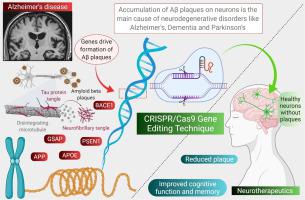Journal of Advanced Research ( IF 11.4 ) Pub Date : 2021-07-06 , DOI: 10.1016/j.jare.2021.07.001 Shanu Bhardwaj 1 , Kavindra Kumar Kesari 2 , Mahesh Rachamalla 3 , Shalini Mani 4 , Ghulam Md Ashraf 5 , Saurabh Kumar Jha 6 , Pravir Kumar 7 , Rashmi K Ambasta 7 , Harish Dureja 8 , Hari Prasad Devkota 9 , Gaurav Gupta 10 , Dinesh Kumar Chellappan 11 , Sachin Kumar Singh 12 , Kamal Dua 13 , Janne Ruokolainen 2 , Mohammad Amjad Kamal 14 , Shreesh Ojha 15 , Niraj Kumar Jha 6

|
Background
Alzheimer's disease (AD) is an insidious, irreversible, and progressive neurodegenerative health condition manifesting as cognitive deficits and amyloid beta (Aβ) plaques and neurofibrillary tangles. Approximately 50 million individuals are affected by AD, and the number is rapidly increasing globally. This review explores the role of CRISPR/Cas9 gene editing in the management of AD and its clinical manifestations.
Aim of Review
This review aims to provide a deep insight into the recent progress in CRISPR/Cas9-mediated genome editing and its use against neurodegenerative disorders, specifically AD. However, we have referred to its use against parkinsons’s disease (PD), Huntington’s disease (HD), and other human diseases, as is one of the most promising and emerging technologies for disease treatment.
Key Scientific Concepts of Review
The pathophysiology of AD is known to be linked with gene mutations, that is, presenilin (PSEN) and amyloid beta precursor protein (APP). However, clinical trials focused at the genetic level could not meet the desired efficiency. The CRISPR/Cas9 genome editing tool is one of the most powerful technologies for correcting inconsistent genetic signatures and now extensively used for AD management. It has significant potential for the correction of undesired gene mutations associated with AD. This technology has allowed the development of empirical AD models, therapeutic lines, and diagnostic approaches for better understanding the nervous system, from in vitro to in vivo models.
中文翻译:

CRISPR/Cas9 基因编辑:阿尔茨海默病治疗的新希望
背景
阿尔茨海默病 (AD) 是一种隐匿的、不可逆的和进行性的神经退行性疾病,表现为认知缺陷和淀粉样蛋白 β (Aβ) 斑块和神经原纤维缠结。大约有 5000 万人受到 AD 的影响,并且这个数字在全球范围内迅速增加。本综述探讨了 CRISPR/Cas9 基因编辑在 AD 管理及其临床表现中的作用。
审查目的
本综述旨在深入了解 CRISPR/Cas9 介导的基因组编辑的最新进展及其对抗神经退行性疾病,特别是 AD。然而,我们提到了它对帕金森病 (PD)、亨廷顿病 (HD) 和其他人类疾病的使用,因为它是最有前途和新兴的疾病治疗技术之一。
审查的关键科学概念
已知 AD 的病理生理学与基因突变有关,即早老素 (PSEN) 和淀粉样蛋白 β 前体蛋白 (APP)。然而,专注于基因水平的临床试验无法达到预期的效率。CRISPR/Cas9 基因组编辑工具是纠正不一致遗传特征的最强大技术之一,现已广泛用于 AD 管理。它具有纠正与 AD 相关的不希望的基因突变的巨大潜力。该技术允许开发经验性 AD 模型、治疗线和诊断方法,以更好地了解从体外到体内模型的神经系统。











































 京公网安备 11010802027423号
京公网安备 11010802027423号